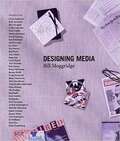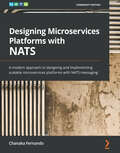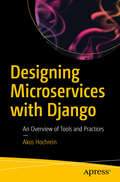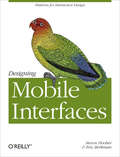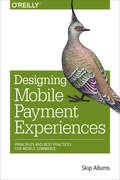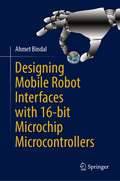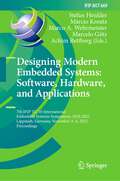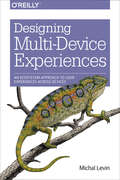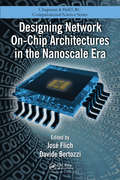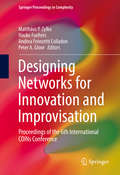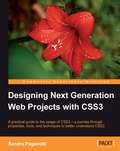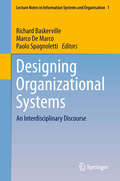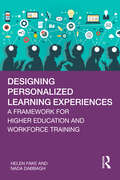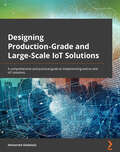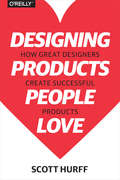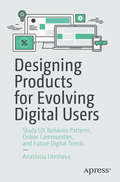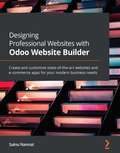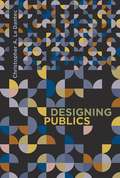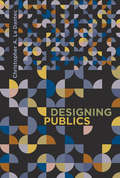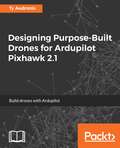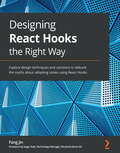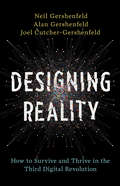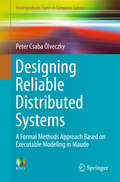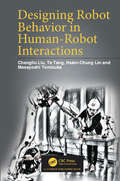- Table View
- List View
Designing Media
by Bill MoggridgeMainstream media, often known simply as MSM, have not yet disappeared in a digital takeover of the media landscape. But the long-dominant MSM―television, radio, newspapers, magazines, and books―have had to respond to emergent digital media. Newspapers have interactive Web sites; television broadcasts over the Internet; books are published in both electronic and print editions. In Designing Media, design guru Bill Moggridge examines connections and conflicts between old and new media, describing how the MSM have changed and how new patterns of media consumption are emerging. The book features interviews with thirty-seven significant figures in both traditional and new forms of mass communication; interviewees range from the publisher of the New York Times to the founder of Twitter. We learn about innovations in media that rely on contributions from a crowd (or a community), as told by Wikipedia's Jimmy Wales and Craigslist's Craig Newmark; how the band OK Go built a following using YouTube; how real-time connections between dispatchers and couriers inspired Twitter; how a BusinessWeek blog became a quarterly printed supplement to the magazine; and how e-readers have evolved from Rocket eBook to QUE. Ira Glass compares the intimacy of radio to that of the Internet; the producer of PBS's Frontline supports the program's investigative journalism by putting documentation of its findings online; and the developers of Google's Trendalyzer software describe its beginnings as animations that accompanied lectures about social and economic development in rural Africa. At the end of each chapter, Moggridge comments on the implications for designing media. Designing Media is illustrated with hundreds of images, with color throughout. A DVD accompanying the book includes excerpts from all of the interviews, and the material can be browsed at www.designing-media.com. Interviews with: Chris Anderson, Rich Archuleta, Blixa Bargeld, Colin Callender, Fred Deakin, Martin Eberhard, David Fanning, Jane Friedman, Mark Gerzon, Ira Glass, Nat Hunter, Chad Hurley, Joel Hyatt, Alex Juhasz, Jorge Just, Alex MacLean, Bob Mason, Roger McNamee, Jeremy Merle, Craig Newmark, Bruce Nussbaum, Alice Rawsthorn, Anna Rosling Rönnlund, Hans Rosling, Ola Rosling, Paul Saffo, Jesse Scanlon, DJ Spooky, Neil Stevenson, Arthur Sulzberger Jr., Shinichi Takemura, James Truman, Jimmy Wales, Tim Westergren, Ev Williams, Erin Zhu, Mark Zuckerberg
Designing Microservices Platforms with NATS: A modern approach to designing and implementing scalable microservices platforms with NATS messaging
by Chanaka FernandoA complete reference for designing and building scalable microservices platforms with NATS messaging technology for inter-service communication with security and observabilityKey FeaturesUnderstand the use of a messaging backbone for inter-service communication in microservices architectureDesign and build a real-world microservices platform with NATS as the messaging backbone using the Go programming languageExplore security, observability, and best practices for building a microservices platform with NATSBook DescriptionBuilding a scalable microservices platform that caters to business demands is critical to the success of that platform. In a microservices architecture, inter-service communication becomes a bottleneck when the platform scales. This book provides a reference architecture along with a practical example of how to implement it for building microservices-based platforms with NATS as the messaging backbone for inter-service communication.In Designing Microservices Platforms with NATS, you'll learn how to build a scalable and manageable microservices platform with NATS. The book starts by introducing concepts relating to microservices architecture, inter-service communication, messaging backbones, and the basics of NATS messaging. You'll be introduced to a reference architecture that uses these concepts to build a scalable microservices platform and guided through its implementation. Later, the book touches on important aspects of platform securing and monitoring with the help of the reference implementation. Finally, the book concludes with a chapter on best practices to follow when integrating with existing platforms and the future direction of microservices architecture and NATS messaging as a whole.By the end of this microservices book, you'll have developed the skills to design and implement microservices platforms with NATS.What you will learnUnderstand the concepts of microservices architectureGet to grips with NATS messaging technologyHandle transactions and message delivery guarantees with microservicesImplement a reference architecture for microservices using NATSDiscover how to improve the platform's security and observabilityExplore how a NATS microservices platform integrates with an enterprise ecosystemWho this book is forThis book is for enterprise software architects and developers who want to gain hands-on microservices experience for designing, implementing, and managing complex distributed systems with microservices architecture concepts. Intermediate-level experience in any programming language and software architecture is required to make the most of this book.
Designing Microservices with Django: An Overview of Tools and Practices
by Akos HochreinExplore microservices using the Python-based Django framework and review the benefits and drawbacks of them. This book will examine what microservices look like, how they talk to each other, and how they are crafted using the Python programming language and the Django web framework.You’ll start by understanding what the key differences are between microservices and monolithic architectures. The book then does a deep dive into how microservices are built and what common models have emerged in our industry. You’ll also take an extensive look at communication and ownership patterns and examine methodologies to speed up your architecture evolution by writing less but more distributed code using the Python programming language and the Django web framework. By the end of the book, you’ll have a solid understanding of microservices architectures. Armed with a comprehensive and solid toolset, you can begin working toward systems that are more scalable, resilient, and maintainable. What You’ll LearnUnderstand the benefits and drawbacks of adopting microservicesDesign systems and architecture for resiliency and distributed ownershipWork with tools for scaling distributed system both in technical and organizational dimensionsExamine the essentials of the Django web framework
Designing Mobile Interfaces: Patterns for Interaction Design
by Steven Hoober Eric BerkmanWith hundreds of thousands of mobile applications available today, your app has to capture users immediately. This book provides practical techniques to help you catch—and keep—their attention. You’ll learn core principles for designing effective user interfaces, along with a set of common patterns for interaction design on all types of mobile devices.Mobile design specialists Steven Hoober and Eric Berkman have collected and researched 76 best practices for everything from composing pages and displaying information to the use of screens, lights, and sensors. Each pattern includes a discussion of the design problem and solution, along with variations, interaction and presentation details, and antipatterns.Compose pages so that information is easy to locate and manipulateProvide labels and visual cues appropriate for your app’s usersUse information control widgets to help users quickly access detailsTake advantage of gestures and other sensorsApply specialized methods to prevent errors and the loss of user-entered dataEnable users to easily make selections, enter text, and manipulate controlsUse screens, lights, haptics, and sounds to communicate your message and increase user satisfaction"Designing Mobile Interfaces is another stellar addition to O’Reilly’s essential interface books. Every mobile designer will want to have this thorough book on their shelf for reference."—Dan Saffer, Author of Designing Gestural Interfaces
Designing Mobile Payment Experiences
by Skip AllumsNow that consumer purchases with mobile phones are on the rise, how do you design a payment app that's safe, easy to use, and compelling? With this practical book, interaction and product designer Skip Allums provides UX best practices and recommendations to help you create familiar, friendly, and trustworthy experiences.Consumers want mobile transactions to be as fast and reliable as cash or bank cards. This book shows designers, developers, and product managers--from startups to financial institutions--how to design mobile payments that not only safeguard identity and financial data, but also provide value-added features that exceed customer expectations.Learn about the major mobile payment frameworks: NFC, cloud, and closed loopExamine the pros and cons of Google Wallet, Isis, Square, PayPal, and other payment appsProvide walkthroughs, demos, and easy registration to quickly gain a new user's trustDesign efficient point-of-sale interactions, using NFC, QR, barcodes, or geolocationAdd peripheral services such as points, coupons and offers, and money management
Designing Mobile Payment Experiences: Principles and Best Practices for Mobile Commerce
by Skip AllumsNow that consumer purchases with mobile phones are on the rise, how do you design a payment app that’s safe, easy to use, and compelling? With this practical book, interaction and product designer Skip Allums provides UX best practices and recommendations to help you create familiar, friendly, and trustworthy experiences.Consumers want mobile transactions to be as fast and reliable as cash or bank cards. This book shows designers, developers, and product managers—from startups to financial institutions—how to design mobile payments that not only safeguard identity and financial data, but also provide value-added features that exceed customer expectations.Learn about the major mobile payment frameworks: NFC, cloud, and closed loopExamine the pros and cons of Google Wallet, Isis, Square, PayPal, and other payment appsProvide walkthroughs, demos, and easy registration to quickly gain a new user’s trustDesign efficient point-of-sale interactions, using NFC, QR, barcodes, or geolocationAdd peripheral services such as points, coupons and offers, and money management
Designing Mobile Robot Interfaces with 16-bit Microchip Microcontrollers
by Ahmet BindalThis textbook provides semester-length coverage of the basics of embedded programming to develop robotics-related projects. The author avoids the typical, theoretical approach of teaching students to develop embedded software using formal methods, in order to emphasize practical and fun projects. Every project detail is explained, including the overall system architecture, working principles of each peripheral device, program development to integrate each peripheral to the system, how to configure the processor, functionality check, operating system, and even developing front-end electronics for some sensors which do not have digital interface.
Designing Modern Embedded Systems: 7th IFIP TC 10 International Embedded Systems Symposium, IESS 2022, Lippstadt, Germany, November 3–4, 2022, Proceedings (IFIP Advances in Information and Communication Technology #669)
by Marcelo Götz Achim Rettberg Marco A. Wehrmeister Márcio Kreutz Stefan HenklerThis book constitutes the refereed proceedings of the 7th IFIP TC 10 International Embedded Systems Symposium, IESS 2022, held in Lippstadt, Germany, during November 3-4, 2022. The 10 full revised papers and 2 short papers presented were carefully reviewed and selected from 13 submissions. The presented research and technical works cover system-level design methods, algorithms, verification and validation techniques, estimation of system properties and characteristics, performance analysis, and real-time systems design. Also, the book presents industrial and real-world application case studies that discuss the challenges and realizations of modern embedded systems, especially when it comes to including artificial intelligence algorithms and techniques in embedded systems.
Designing Multi-Device Experiences: An Ecosystem Approach to User Experiences across Devices
by Michal LevinWelcome to our multi-device world, a world where a user’s experience with one application can span many devices—a smartphone, a tablet, a computer, the TV, and beyond. This practical book demonstrates the variety of ways devices relate to each other, combining to create powerful ensembles that deliver superior, integrated experiences to your users.Learn a practical framework for designing multi-device experiences, based on the 3Cs—Consistent, Complementary, and Continuous approachesGraduate from offering everything on all devices, to delivering the right thing, at the right time, on the best (available) deviceApply the 3Cs framework to the broader realm of the Internet of Things, and design multi-device experiences that anticipate a fully connected worldLearn how to measure your multi-device ecosystem performanceGet ahead of the curve by designing for a more connected future
Designing Network On-Chip Architectures in the Nanoscale Era
by Davide Bertozzi José FlichGoing beyond isolated research ideas and design experiences, Designing Network On-Chip Architectures in the Nanoscale Era covers the foundations and design methods of network on-chip (NoC) technology. The contributors draw on their own lessons learned to provide strong practical guidance on various design issues.Exploring the design process of the
Designing Networks for Innovation and Improvisation
by Matthäus P. Zylka Hauke Fuehres Andrea Fronzetti Colladon Peter A. GloorThis volume is focused on the emerging concept of Collaborative Innovation Networks (COINs). COINs are at the core of collaborative knowledge networks, distributed communities taking advantage of the wide connectivity and the support of communication technologies, spanning beyond the organizational perimeter of companies on a global scale. It includes the refereed conference papers from the 6th International Conference on COINs, June 8-11, 2016, in Rome, Italy. It includes papers for both application areas of COINs, (1) optimizing organizational creativity and performance, and (2) discovering and predicting new trends by identifying COINs on the Web through online social media analysis. Papers at COINs16 combine a wide range of interdisciplinary fields such as social network analysis, group dynamics, design and visualization, information systems and the psychology and sociality of collaboration, and intercultural analysis through the lens of online social media. They will cover most recent advances in areas from leadership and collaboration, trend prediction and data mining, to social competence and Internet communication.
Designing Next Generation Web Projects with CSS3
by Sandro PaganottiThis book is designed for you if you are a frontend web developer; it requires a solid knowledge of CSS syntax and of the most common CSS2 properties and selectors.
Designing Organizational Systems
by Paolo Spagnoletti Marco De Marco Richard BaskervilleThis book is dedicated to the memory of Professor Alessandro (Sandro) D'Atri, who passed away in April 2011. Professor D'Atri started his career as a brilliant scholar interested in theoretical computer science, databases and, more generally information processing systems. He journeyed far in various applications, such as human-computer interaction, human factors, ultimately arriving at business information systems and business organisation after more than 20 years of researc hbased on "problem solving". Professor D'Atri pursued the development of an interdisciplinary culture in which social sciences, systems design and human sciences are mutually integrated. Rather than retrospection, this book is aimed to advance in these directions and to stimulate a debate about the potential of design research in the field of information systems and organisation studies with an interdisciplinary approach. Each chapter has been selected by the Editorial Board following a double blind peer review process. The general criteria of privileging the variety of topics and the design science orientation and/or empirical works in which a design research approach is adopted to solve various field problems in the management area. In addition several chapters contribute to the meta-discourse on design science research.
Designing Personalized Learning Experiences: A Framework for Higher Education and Workforce Training
by Nada Dabbagh Helen FakeDesigning Personalized Learning Experiences offers theoretically grounded and pragmatic approaches to designing personalized learning initiatives for higher education and organizational contexts. With current research concluding that a multitude of variables can enable learners to direct their own experiences and achieve their goals, new guidance is needed to hone the range of instructional approaches, activities, and interactions available to support adult learners. This book offers practical strategies on how to design and implement effective personalized learning interventions, advance learning and engagement, encourage ownership over the learning process, and decrease attrition. Professionals in instructional design, learning and development, organizational development, consultancies, and beyond will be emboldened by the work to leverage a mix of technology-enabled social and content interactions.
Designing Production-Grade and Large-Scale IoT Solutions: A comprehensive and practical guide to implementing end-to-end IoT solutions
by Mohamed AbdelazizGet to grips with key IoT aspects along with modern trends, architectures, and technologies that support IoT solutions, such as cloud computing, modern app architecture paradigms, and data analyticsKey FeaturesUnderstand the big picture of designing production-grade IoT solutions from an industry expertGet up and running with the development and designing aspects of the Internet of ThingsSolve business problems specific to your domain using different IoT platforms and technologiesBook DescriptionWith the rising demand for and recent enhancements in IoT, a developer with sound knowledge of IoT is the need of the hour. This book will help you design, build, and operate large-scale E2E IoT solutions to transform your business and products, increase revenue, and reduce operational costs.Starting with an overview of how IoT technologies can help you solve your business problems, this book will be a useful guide to helping you implement end-to-end IoT solution architecture. You'll learn to select IoT devices; real-time operating systems; IoT Edge covering Edge location, software, and hardware; and the best IoT connectivity for your IoT solution. As you progress, you'll work with IoT device management, IoT data analytics, IoT platforms, and put these components to work as part of your IoT solution. You'll also be able to build IoT backend cloud from scratch by leveraging the modern app architecture paradigms and cloud-native technologies such as containers and microservices. Finally, you'll discover best practices for different operational excellence pillars, including high availability, resiliency, reliability, security, cost optimization, and high performance, which should be applied for large-scale production-grade IoT solutions.By the end of this IoT book, you'll be confident in designing, building, and operating IoT solutions.What you will learnUnderstand the detailed anatomy of IoT solutions and explore their building blocksExplore IoT connectivity options and protocols used in designing IoT solutionsUnderstand the value of IoT platforms in building IoT solutionsExplore real-time operating systems used in microcontrollersAutomate device administration tasks with IoT device managementMaster different architecture paradigms and decisions in IoT solutionsBuild and gain insights from IoT analytics solutionsGet an overview of IoT solution operational excellence pillarsWho this book is forThis book is for E2E solution architects, systems and technical architects, and IoT developers looking to design, build, and operate E2E IoT applications and solutions. Basic knowledge of cloud computing, software engineering, and distributed system design will help you get the most out of this book.
Designing Products People Love: How Great Designers Create Successful Products
by Scott HurffHow can you create products that successfully find customers? With this practical book, you’ll learn from some of the best product designers in the field, from companies like Facebook and LinkedIn to up-and-coming contenders. You’ll understand how to discover and interpret customer pain, and learn how to use this research to guide your team through each step of product creation.Written for designers, product managers, and others who want to communicate better with designers, this book is essential reading for anyone who contributes to the product creation process.Understand exactly who your customers are, what they want, and how to build products that make them happyLearn frameworks and principles that successful product designers useIncorporate five states into every screen of your interface to improve conversions and reduce perceived loading timesDiscover meeting techniques that Apple, Amazon, and LinkedIn use to help teams solve the right problems and make decisions fasterDesign effective interfaces across different form factors by understanding how people hold devices and complete tasksLearn how successful designers create working prototypes that capture essential customer feedbackCreate habit-forming and emotionally engaging experiences, using the latest psychological research
Designing Products for Evolving Digital Users: Study UX Behavior Patterns, Online Communities, and Future Digital Trends
by Anastasia UteshevaDigital user behavior is evolving at an ever-increasing pace, and predicting future trends is a booming business as a result. Users associate technology with their identities now more than ever, and it is up to you as a product designer to enhance their experience for the better. Designing Products for Evolving Digital Users is a 21st century handbook that helps you do just that. By providing insights that allow you to study UX (user experience) behavior patterns, online communities, and future digital trends, Designing Products for Evolving Digital Users instills confidence and fact-based foundations for your digital creations. Author Anastasia Utesheva expertly teaches you how to account for the way the technology impacts the identity of users and how that identity shifts through ongoing interaction with a product or service. She also brings in important case studies on social media, gaming, eRetail, and more to illustrate past examples of technology’s profound impact on communal and individual identity. Digital product design’s ultimate end goal is end user satisfaction. While a myriad of material is available out there consisting of simple tips and tricks for optimal digital design, Designing Products for Evolving Digital Users is a rare and remarkable title that cohesively accounts for all environmental factors involved. Comprehend how distributed technology impacts creation and negotiation of identity and explore communities that form around digital products. UX designers, futurists, students, and industry veterans alike have an abundance of invaluable learning ahead of them in Designing Products for Evolving Digital Users. What You Will LearnLearn how to design digital products/services that resonate with and transform identity of usersStudy how digital impacts formation of identityConsider how digital technology has impacted our world and implications for future digital trendsWho This Book Is For UX designers, digital product creators, entrepreneurs, educators, philosophy of technology enthusiasts, futurists
Designing Professional Websites with Odoo Website Builder: Create and customize state-of-the-art websites and e-commerce apps for your modern business needs
by Sainu NannatA practical guide to crafting elegant, intuitive, and customer-friendly websites to deliver a high-quality user experience using the powerful features of the Odoo website builderKey FeaturesUnderstand website creation using the Odoo website builder and learn how to make the most of itExtend your website by configuring the additional tools and functional optionsLearn about manageability and real-time functioning of the website using various operational toolsBook DescriptionThe Odoo website builder is an operational tool in the Odoo platform that allows you to design, develop, and manage a website. This book introduces and explains all the features of the Odoo website builder that will help you to be more productive while creating websites. The book starts with an overview of the Odoo website builder, its functionalities, and the tools it offers. Using descriptive illustrations and practical examples, you'll gain detailed insights into the block operations of the Odoo website builder and learn how to work with structure blocks, features blocks, and dynamic content blocks. As you advance, you'll discover how to use the HTML, CSS, or JS editor in Odoo website builder applications for customization. This Odoo book will take you through the different aspects of website building and show you how e-commerce websites can be designed and developed using website builder applications. You'll build a website, manage it, and run a discussion forum in Odoo using the website builder, and apply your knowledge to add a live chat tool that can be incorporated into your website using the Odoo website builder. By the end of this book, you'll have gained a solid understanding of the Odoo website builder and be able to leverage its features to develop your own website.What you will learnFind out how to implement structure blocks while developing a websiteWork with dynamic content blocks and inner content blocks in the Odoo website builderUse an HTML, CSS, or JS editor in the Odoo website builder to customize applicationsCreate and design a blog with the Odoo website builderBuild a fully functional e-commerce website and a discussion forum using the Odoo website builderTrack visitors on the website and understand the live chat tool and its functionalityWho this book is forThis book is for Odoo users, functional consultants, techno-functional consultants, web designers, and anyone looking to create impressive websites. Odoo developers will also find the book useful for building their website for the end user. Basic functional knowledge of Odoo is all that you need to get started with this book.
Designing Publics
by Christopher A. Le DantecContemporary computing technologies have thoroughly embedded themselves in every aspect of modern life -- conducting commerce, maintaining and extending our networks of friends, and mobilizing political movements all occur through a growing collection of devices and services designed to keep and hold our attention. Yet what happens when our attention needs to be more local, collective, and focused on our immediate communities? Perhaps more important, how can we imagine and create new technologies with local communities? In Designing Publics, Christopher Le Dantec explores these questions by designing technologies with the urban homeless. Drawing on a case study of the design of a computational infrastructure in a shelter for homeless women and their children, Le Dantec theorizes an alternate vision of design in community contexts.Focusing on collective action through design, Le Dantec investigates the way design can draw people together on social issues and create and sustain a public. By "designing publics" he refers both to the way publics arise out of design intervention and to the generative action publics take -- how they "do design" as they mobilize and act in the world. This double lens offers a new view of how design and a diverse set of design practices circulate in sites of collective action rather than commercial production.
Designing Publics (Design Thinking, Design Theory)
by Christopher A. Le DantecAn exploration of design considerations in the design of technologies that support local collective action.Contemporary computing technologies have thoroughly embedded themselves in every aspect of modern life—conducting commerce, maintaining and extending our networks of friends, and mobilizing political movements all occur through a growing collection of devices and services designed to keep and hold our attention. Yet what happens when our attention needs to be more local, collective, and focused on our immediate communities? Perhaps more important, how can we imagine and create new technologies with local communities? In Designing Publics, Christopher Le Dantec explores these questions by designing technologies with the urban homeless. Drawing on a case study of the design of a computational infrastructure in a shelter for homeless women and their children, Le Dantec theorizes an alternate vision of design in community contexts.Focusing on collective action through design, Le Dantec investigates the way design can draw people together on social issues and create and sustain a public. By “designing publics” he refers both to the way publics arise out of design intervention and to the generative action publics take—how they “do design” as they mobilize and act in the world. This double lens offers a new view of how design and a diverse set of design practices circulate in sites of collective action rather than commercial production.
Designing Purpose-Built Drones for Ardupilot Pixhawk 2.1: Build drones with Ardupilot
by Ty Audronis Lucas De Marchi Ayan Pahwa Ersin GonulKey Features Explore the best practices used by the top industry professionals that will not only help you build drones in time, but also build effective solutions to cater to. Navigate through the complexities of Ardupilot to put together a complete functional UAV and assemble your drone Learn through practical examples that help you build robust UAV flight and ground control components Book Description The Ardupilot platform is an application ecosystem that encompasses various OS projects for drone programming, flight control, and advanced functionalities.The Ardupilot platform supports many Comms and APIs, such as DroneKit, ROS, and MAVLink. It unites OS drone projects to provide a common codebase. With the help of this book, you will have the satisfaction of building a drone from scratch and exploring its many recreational uses (aerial photography, playing, aerial surveillance, and so on). This book helps individuals and communities build powerful UAVs for both personal and commercial purposes. You will learn to unleash the Ardupilot technology for building, monitoring, and controlling your drones.This is a step-by-step guide covering practical examples and instructions for assembling a drone, building ground control unit using microcontrollers, QgroundControl, and MissionPlanner. You can further build robotic applications on your drone utilizing critical software libraries and tools from the ROS framework. With the help of DroneKit and MAVLink (for reliable communication), you can customize applications via cloud and mobile to interact with your UAV. What you will learn Kitbash "dumb" objects into smart ones Program Pixhawk for your drones Fabricate your own parts out of different materials Integrate Pixhawk into different types of drones Build and understand the significant difference between land, sea, and air drones Adapt old Pixhawk sensors to the new Pixhawk 2.1 plugs Become familiar with procedures for testing your new drones
Designing React Hooks the Right Way: Explore design techniques and solutions to debunk the myths about adopting states using React Hooks
by Fang Jin Sagar KaleGet to grips with React Hooks and design your own custom Hook to manage application states for making better decisions in site architectureKey FeaturesGet to grips with Hooks' design and understand each built-in Hook's pitfalls with examplesDiscover how to turn your existing code into a reusable Hook via code refactoringExplore design solutions to identify and solve site performance issues involving HooksBook DescriptionReact hook creates a unique solution for using states in function components to orchestrate UI communication. They provide you with an easy interface to write custom data management solutions with low development and maintenance costs. Understanding how Hooks are designed enables you to use them more effectively, and this book helps you to do just that.This book starts with a custom-crafted solution to reveal why Hooks are needed in the first place. You will learn about the React engine and discover how each built-in Hook can manage a persistent value by hooking into it. You will walk through the design and implementation of each hook with code so that you gain a solid understanding. Finally, you'll get to grips with each Hook's pitfalls and find out how to effectively overcome them.By the end of this React book, you'll have gained the confidence to build and write Hooks for developing functional and efficient web applications at scale.What you will learnCreate your own hooks to suit your state management requirementDetect the current window size of your website using useEffectDebounce an action to improve user interface (UI) performance using useMemoEstablish a global site configuration using useContextAvoid hard-to-find application memory leaks using useRefDesign a simple and effective API data layer using custom HooksWho this book is forThis book is for web developers who are looking for a consistent and efficient approach for applying application states with Hooks. Basic knowledge of React will help you to get the most out of this book.
Designing Reality: How to Survive and Thrive in the Third Digital Revolution
by Neil Gershenfeld Alan Gershenfeld Joel Cutcher-GershenfeldThat's the promise, and peril, of the third digital revolution, where anyone will be able to make (almost) anythingTwo digital revolutions--computing and communication--have radically transformed our economy and lives. A third digital revolution is here: fabrication. Today's 3D printers are only the start of a trend, accelerating exponentially, to turn data into objects: Neil Gershenfeld and his collaborators ultimately aim to create a universal replicator straight out of Star Trek. While digital fabrication promises us self-sufficient cities and the ability to make (almost) anything, it could also lead to massive inequality. The first two digital revolutions caught most of the world flat-footed, thanks to Designing Reality that won't be true this time.
Designing Reliable Distributed Systems
by Peter Csaba ÖlveczkyThis classroom-tested textbook provides an accessible introduction to the design, formal modeling, and analysis of distributed computer systems. The book uses Maude, a rewriting logic-based language and simulation and model checking tool, which offers a simple and intuitive modeling formalism that is suitable for modeling distributed systems in an attractive object-oriented and functional programming style.Topics and features: introduces classical algebraic specification and term rewriting theory, including reasoning about termination, confluence, and equational properties; covers object-oriented modeling of distributed systems using rewriting logic, as well as temporal logic to specify requirements that a system should satisfy; provides a range of examples and case studies from different domains, to help the reader to develop an intuitive understanding of distributed systems and their design challenges; examples include classic distributed systems such as transport protocols, cryptographic protocols, and distributed transactions, leader election, and mutual execution algorithms; contains a wealth of exercises, including larger exercises suitable for course projects, and supplies executable code and supplementary material at an associated website.This self-contained textbook is designed to support undergraduate courses on formal methods and distributed systems, and will prove invaluable to any student seeking a reader-friendly introduction to formal specification, logics and inference systems, and automated model checking techniques.
Designing Robot Behavior in Human-Robot Interactions
by Changliu Liu Te Tang Hsien-Chung Lin Masayoshi TomizukaIn this book, we have set up a unified analytical framework for various human-robot systems, which involve peer-peer interactions (either space-sharing or time-sharing) or hierarchical interactions. A methodology in designing the robot behavior through control, planning, decision and learning is proposed. In particular, the following topics are discussed in-depth: safety during human-robot interactions, efficiency in real-time robot motion planning, imitation of human behaviors from demonstration, dexterity of robots to adapt to different environments and tasks, cooperation among robots and humans with conflict resolution. These methods are applied in various scenarios, such as human-robot collaborative assembly, robot skill learning from human demonstration, interaction between autonomous and human-driven vehicles, etc. Key Features: Proposes a unified framework to model and analyze human-robot interactions under different modes of interactions. Systematically discusses the control, decision and learning algorithms to enable robots to interact safely with humans in a variety of applications. Presents numerous experimental studies with both industrial collaborative robot arms and autonomous vehicles.
